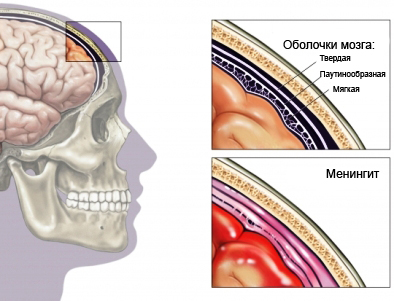Bacterial meningitis – Cerebrospinal meningitis – Spinal meningitis
Description of bacterial meningitis
The brain and spinal cord are located between layers of tissue, which are called pia maters. Certain bacteria can cause infection in these layers. This condition called bacterial meningitis.
Bacterial meningitis – serious infection, which can cause death within hours. Rapid diagnosis and timely treatment are vital.

Causes of bacterial meningitis
Meningitis is mainly caused by upper respiratory tract infections.. Once infected, they travel with the bloodstream to the brain.
Worldwide, most cases of acute bacterial meningitis are caused by three types of bacteria:
- Bacteria, causing pneumonia – streptococcal bacteria;
- Meningococcus (Neisseria meningitidis);
- Haemophilus influenzae.
Other forms of bacterial meningitis may be caused by the following bacteria:
- Listeria monocytogenes – listeria;
- Escherichia coli – Escherichia coli;
- Mycobacterium tuberculosis – mycobacterium tuberculosis;
- Group B Streptococcus.
Newborns and the elderly are more likely to get meningitis.
Some forms of meningitis are transmitted by direct contact with fluid from the mouth or throat of an infected person.. This can happen while kissing or using someone else's utensils.. In general, meningitis is not transmitted through casual contact..
Risk factors
If you have risk factors for developing meningitis, tell your doctor:
- Age: infancy and early childhood or older 60 years;
- Being in close and prolonged contact with patients with meningitis, caused by Neisseria meningitidis;
- Weakened immune system due to HIV infection or other diseases;
- Alcoholism;
- Smoking (for meningitis, caused by Neisseria meningitidis) or long-term exposure to secondhand smoke;
- Living in close proximity to a large number of people, eg, in hostels or barracks (for meningitis, caused by Neisseria meningitidis).
Symptoms of bacterial meningitis
Classic symptoms may develop within hours, or may take from 1 to 2 days:
- Heat;
- Headache;
- Very tough, sore neck.
Other symptoms may include:
- Red or purple skin rash;
- Cyanosis (bluish skin color);
- Nausea;
- Vomiting;
- Photophobia (sensitivity to bright light);
- Drowsiness;
- Confusion.
In newborns and infants, symptoms are difficult to see. As a result, children under three months of age with a high fever are often tested for meningitis.. Symptoms in newborns and infants, may include:
- Inactivity;
- Unexplained high fever or temperature instability, including low body temperature;
- Irritability;
- Vomiting;
- Jaundice (yellow skin color);
- Poor appetite;
- Tightness or bulging of tissues between the bones of the skull;
- Difficulty waking up.
If the disease progresses, seizures and/or hearing loss may occur.. It can happen to patients of all ages.
Diagnosis of bacterial meningitis
Doctor asks about symptoms and medical history and performs a physical examination.
Tests to diagnose bacterial meningitis may include the following:
- Spinnomozgovaya puncture – withdrawing a small amount of cerebrospinal fluid to check for bacteria;
- Testing blood samples, Urine, mucus, and/or pus from skin infections;
- MRI scan – test, which uses magnetic waves, to take pictures of body structure (To make sure, that the inflammation did not occur for another reason, eg, due to tumor);
- CT scan – type of X-ray examination, which uses computer, to make pictures of structures inside the body.
Treatment of bacterial meningitis
More 90% of all people with this infection survive, if they receive immediate assistance, including:
- Antibiotics and corticosteroids, often co-administered;
- Supportive fluids may also be given intravenously..
Treatment for bacterial meningitis includes:
Antibiotics
Antibiotics are given directly into a vein as soon as an infection is suspected. Antibiotics may be prescribed after tests, if the exact cause of bacterial meningitis is established. Patients usually stay in the hospital, until the temperature drops and the fluids around the spine and brain are cleared of infection.
Corticosteroids
Usually given intravenously at the start of treatment. They stabilize pressure and swelling of the brain, and reduce the production of inflammatory substances in the body. This treatment may prevent further tissue damage..
Introduction of fluids
Body fluids may be lost due to fever, sweating or vomiting. To make up for losses, they are administered intravenously.. It must be done carefully, to avoid complications from excess fluid.
Other medicines to treat bacterial meningitis
- Painkillers and sedatives may be used ;
- Anticonvulsants may be prescribed to prevent seizures.
Prevention of bacterial meningitis
To reduce the risk of bacterial meningitis, you must take the following steps:
- Ask your doctor which vaccines to give to prevent bacterial meningitis. Examples include:
- Hib vaccine;
- Pneumococcal vaccine;
- Meningococcal vaccine;
- If in close contact with infected meningitis, prophylactic antibiotics should be taken;
- Need to buy pasteurized milk and dairy products. It can prevent meningitis, caused by Listeria monocytogenes;
- During pregnancy, the doctor should ensure that, so that the infection is not transmitted to the child.
